Astronomy Focus: Ten strangest galaxies in the universe
Everyone has seen galaxies in science books, on TV shows or maybe even on the news at some point but not all galaxies are created the same. In fact many are completely bizarre. While our own galaxy, the Milky Way, may look flawless, the following galaxies are strange, fascinating and awe-inspiring!
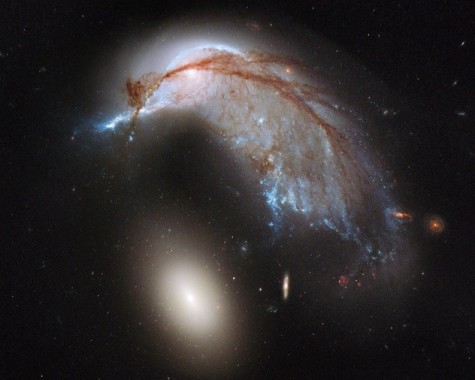
10. The Porpoise Galaxy-NGC 2936
This galaxy is located in the “Hydra” constellation. It bears a striking resemblance to a dolphin, however others have argued that it looks more like a penguin protecting an egg. In reality however, it is a two-galaxy system where the “egg” is different galaxy entirely- Arp 142- and the “dolphin” is a part of NGC 2936. The dolphin actually used to be a spiral galaxy similar to our Milky Way, but because of the enormous gravitational forces of the dense galaxy below it it has contorted into the shape we see today. The “eye” of the dolphin is what used to be the spiral galaxy’s core. Within a billion years or so the two galaxies will merge together. For now however, we should enjoy the view of such whimsical animals in space, whichever one you see!
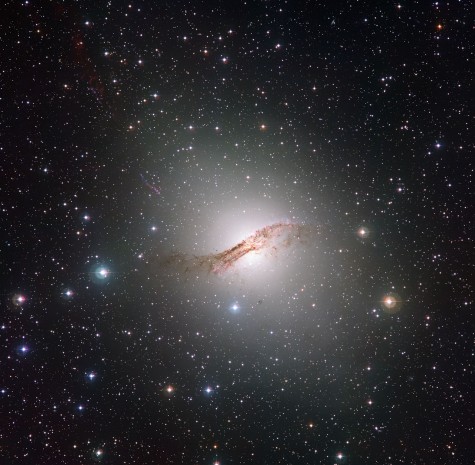
9. Centaurus A
Whenever you first look at this large galaxy you may not notice anything strange going on with this mammoth, but when you take a closer look there is definitely something bizarre going on here. Galaxies usually come in one of two shapes: spiral or elliptical. However when astronomers use radio imaging to look under the dust, they discovered that there is a spiral hidden underneath. This is the only elliptical galaxy we have found that has spiral arms. It is believed that millions of years ago Centaurus A absorbed a spiral galaxy, however these mergers have never before left the spiral arms intact. Scientists are still trying to figure out the oddball that is Centaurus A.

8. J1649+2635
Nearly 800 million light-years away from earth, J1649+2635 is member of a particularly rare type of galaxies, with only three others like it found so far. This strange galaxy is a spiral shaped galaxy like our own, however scientists have noticed jets of subatomic particles being shot off into space from it’s huge black-hole core at nearly the speed of light.The problem with this however is that scientist used to think such jets could only come elliptical shaped galaxies that have merged with spiral galaxies. However J1649+2635 is not only bizarre because of it’s jets, it is also the first example of a “grand design” spiral galaxy with a large “halo” of visible-light emission surrounding it. The discovery of J1649+2635 excited many astronomers and they are still exploring all the mysteries it hides.
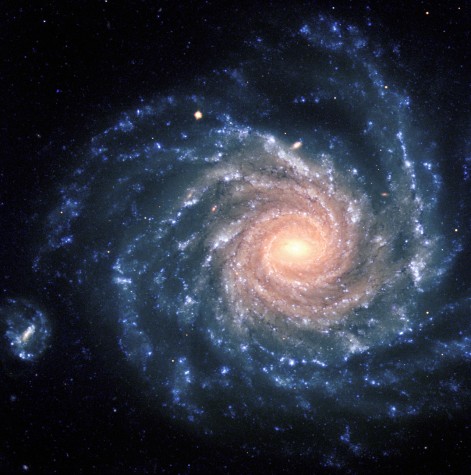
7. NGC 1232
Located in the Eridanus constellation, about 60 million light-years away and about twice the size of the Milky Way, NGC 1232 is a fascinating discovery. Across it’s middle is a hot gas cloud that scientists believe is the remains of a dwarf galaxy that collided with NGC 1232. Astronomers theorize that the collision created a shock wave that triggered the formation of massive stars that will last around 50 million more years.(seen to the far right of the image) This is the first time the aftermath of a galactic collision has ever been seen. Astronomers are hopeful that they will be able to learn more about the evolution of galaxies from this stellar firework display.

6. Arp 220
Also known as IC 4553 this galaxy has a complex shape that is neither elliptical or spiral. It also contains two cores that are separated by 20,000 light-years, leading scientists to believe that two galaxies recently collided and merged. Located in the Serpens Caput constellation about 239 million light-years away, Arp 220 is one of the most luminous galaxies known because of an enormous burst of star-forming activity within the galactic nuclei. Every second, it radiates more energy than two trillion stars that is mostly infrared. However one fact that adds to this galaxy’s uniqueness is the fact that it also radiates a form of radio emission found commonly under laboratory conditions: maser emission. Scientists are still trying to understand how the maser mechanism is produced in such a large object and what the energy mechanism is that operates in such a small region of space.
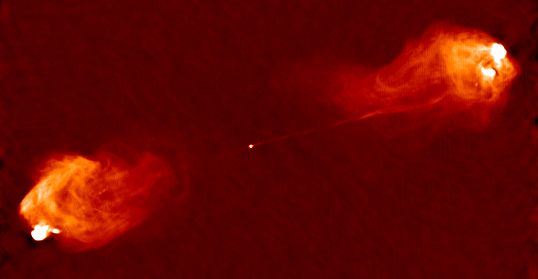
5. Cygnus-A
This peculiar looking galaxy probably wouldn’t have gotten looked twice at by the science community, if it wasn’t for the fact that it’s the host of the largest radio source in the sky (aside from the sun). Nearly 600 million light-years away, this galaxy is among the giants of the universe with a mass estimated to be about 100 trillion time that of the sun. Consisting of two cores, it is apparent that Cygnus-A merged with another galaxy that passed too close. The radio power coming from Cygnus-A exceeds the total electromagnetic output of over 2 trillion stars, which is not surprising in and of itself, because it contains enough mass for 100 trillion. What makes makes this huge output phenomenal is the fact that it comes from two separate clouds on either side of the galaxy. These clouds are made of a hot plasma of electrons that move across magnetic fields at nearly the speed of light. These clouds are thought to have been created and replenished by jets of relativistic plasma ejected by the galactic cores. Scientists are still trying to unravel was causes this unusual ejection, however current thinking suggests that in the cores of these galaxies there are gigantic billion-solar-mass black holes.
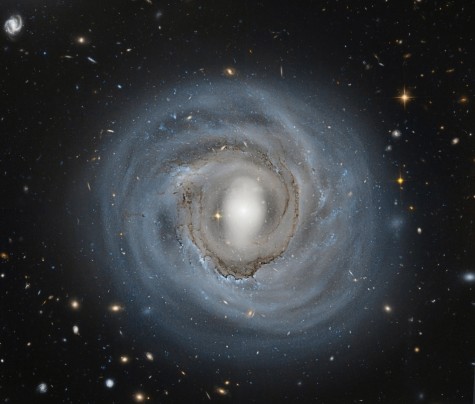
4. NGC 4921
Discovered in the late 18th century by William Herschel, it is one of the brightest galaxies in what is known as the Coma Galaxy Cluster. NGC 4921 is an example of a rare type of spiral galaxy known as and “anemic spiral” where the normal star formation rate is less intense, and as a result create a ring of dust around the galaxy accompanied by young blue stars. Nearly 320 million light-years away, this rare galaxy is providing information to help astronomers to refine allow a better distance determination to one of the largest nearby clusters in the local universe. Also, a more precise determination could be coupled with its known recession speed to help humanity better calibrate the expansion rate of the entire visible universe.
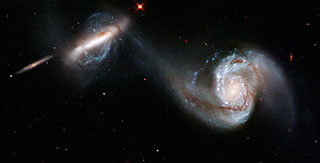
3. Arp 87
Arp 87 is a collective for a pair of two galaxies, and it is also a great example of a near miss of a galactic collision. One of the first discoveries about this pair was that the galaxies have very active star formation and contain large numbers of super star clusters – clusters more compact and richer in young stars than astronomers were used to seeing in the area near our solar system.Found in the constellation Leo, these two galaxies almost collided a few billion years ago, leaving material strung out between them as they moved back apart. It is likely they will continue to have a series of near misses before they eventually collide together in an explosion of galactic proportions. For now, however, they are tethered together by a thin stream of stars, gas, and dust particles, like enormous intergalactic bolas.
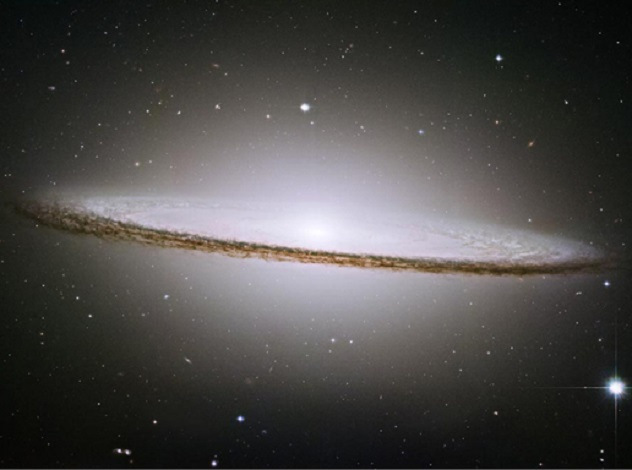
2. Sombrero Galaxy
This galaxy bears a striking resemblance to the hat of the same name. With a sweeping brim of dust, gas and stars, and a bulge in the center this galaxy makes for quite the head-scratcher for scientists. As you look at the center you can actually see that it’s made up of several different clusters of stars, instead of just one big one and it is highly likely that there is a massive black hole near the center. The brim is also very strange. Scientists still are unsure as to how rings like this are able to form, though it theorized that perhaps the ring is formed by material swirling around the black hole.
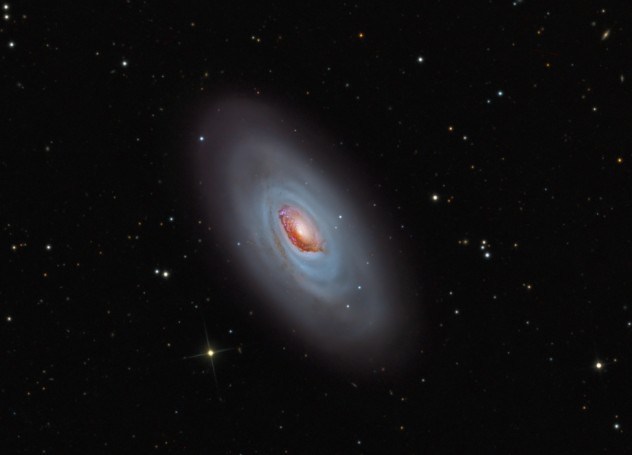
1. The Black Eye Galaxy- M64
Also known the sleeping beauty galaxy, this magnificent galaxy is rife with creation, as it’s reddish color indicates. Red means an abundance of hydrogen, which means stars are being formed. Strangely though, the stars and gas in the reddish portion is rotating one way, while it’s immense cloud of gas and dust is rotating the other. while this is very bizarre, it is thought to be the result of a galactic collision.
Images Courtesy of:
http://www.nasa.gov/– NGC 2936, Centaurus A, NGC 4921, Sombrero Galaxy, The Black Eye Galaxy and Cygnus-A
http://www.sdss.org/– J1649+2635,
http://www.eso.org/– NGC 1232
http://www.spacetelescope.org/– Arp 220 and Arp 87

Hey! My name is Kathleen Cempa and I attend the Grier School for girls as a sophomore! I’ve spent my entire life here in Tyrone and attended school at...











Philip Hillman • Nov 10, 2023 at 1:30 pm
I love this article! I find the variety and magnificence of the universe endlessly fascinating.
In your journalistic career, it will be important to learn the difference between “its” and “it’s”.
No need to publish the comment, unless you want to publish the first part only.